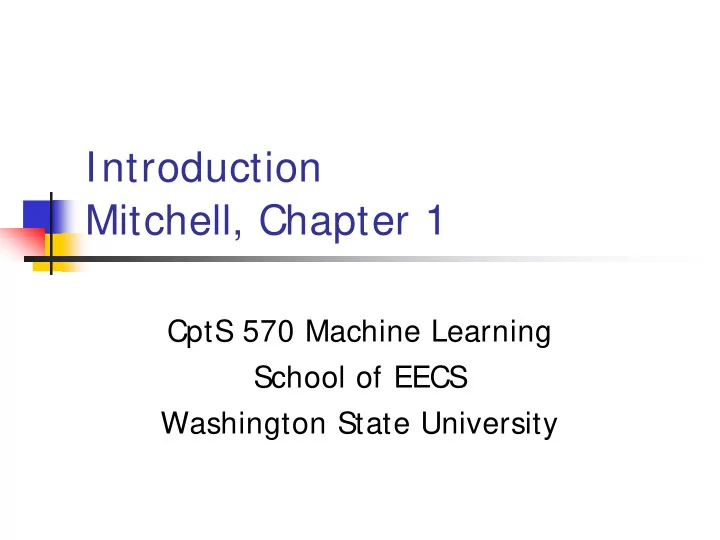

Introduction Mitchell, Chapter 1 CptS 570 Machine Learning School of EECS Washington State University
Outline Why machine learning Some examples Relevant disciplines What is a well-defined learning problem Learning to play checkers Machine learning issues Best computer checkers player
Why Machine Learning? New kind of capability for computers Database mining Medical records medical knowledge Self customizing programs Learning junk mail filter Applications we can't program by hand Autonomous driving Speech recognition Understand human learning and teaching Time is right Recent progress in algorithms and theory Growing flood of online data Computational power is available Budding industry
Example: Rule and Decision Tree Learning Data: Learned rule: If No previous vaginal delivery, and Abnormal 2nd Trimester Ultrasound, and Malpresentation at admission, and No Elective C-Section Then Probability of Emergency C-Section is 0.6 Over training data: 26/41 = .634 Over test data: 12/20 = .600
Example: Neural Network Learning ALVINN (Autonomous Land Vehicle In a Neural Network) drives 70 mph on highways $2M DARPA Grand Challenge www.darpa.mil/grandchallenge
Relevant Disciplines Artificial intelligence Statistics Computational complexity theory Control theory Information theory Psychology Neuroscience Philosophy
What is the Learning Problem? Learning = Improving with experience at some task Improve over task T, with respect to performance measure P, based on experience E. E.g., Learn to play checkers T: Play checkers P: % of games won in world tournament E: opportunity to play against self
Learning to Play Checkers T: Play checkers P: Percent of games won in world tournament What experience? What exactly should be learned? How shall it be represented? What specific algorithm to learn it?
Type of Training Experience Direct or indirect? Teacher or not? Problem Is training experience representative of performance goal?
Choose the Target Function ChooseMove : Board Move ?? ℜ V : Board ?? …
Possible Definition for Target Function V If b is a final board state that is won , then V(b) = 100 If b is a final board state that is lost , then V(b) = -100 If b is a final board state that is a draw , then V(b) = 0 If b is not a final state in the game, then V(b) = V(b’), where b’ is the best final board state that can be achieved starting from b and playing optimally until the end of the game This gives correct values, but is not operational
Choose Representation for Target Function Collection of rules? Neural network? Polynomial function of board features? …
A Representation for Learned Function = + ⋅ + ⋅ + ⋅ + ˆ V ( b ) w w bp ( b ) w rp ( b ) w bk ( b ) 0 1 2 3 ⋅ + ⋅ + ⋅ ( ) ( ) ( ) w rk b w bt b w rt b 4 5 6 bp(b): number of black pieces on board b rp(b): number of red pieces on b bk(b): number of black kings on b rk(b): number of red kings on b bt(b): number of red pieces threatened by black (i.e., which can be taken on black's next turn) rt(b): number of black pieces threatened by red
Obtaining Training Examples V (b): the true target function ˆ (b): the learned function V V train (b): the training value One rule for estimating training values: ˆ V train (b) V (Successor(b))
Choose Weight Tuning Rule LMS Weight update rule: Do repeatedly: Select a training example b at random 1. Compute error(b): = − ˆ error ( b ) V ( b ) V ( b ) train 2. For each board feature f i , update weight w i : ← + ⋅ ⋅ w w c f error ( b ) i i i c is some small constant, say 0.5, to control the rate of learning
Design Choices
Machine Learning Issues What algorithms can approximate functions well (and when)? How does number of training examples influence accuracy? How does complexity of hypothesis representation influence accuracy? How does noisy data influence accuracy? What are the theoretical limits of learnability? How can prior knowledge of learner help? What clues can we get from biological learning systems? How can systems alter their own representations?
Best Computer Checkers Player Reigning champion: Chinook (1996) www.cs.ualberta.ca/~ chinook Search Parallel alpha-beta Evaluation function Linear combination of ~ 20 weighted features Weights hand-tuned (learning ineffective) End-game database Opening book database
Checkers is Solved Chinook team weakly solves checkers (2007) Ultra-weakly solved Perfect play result is known, but not a strategy for achieving the result Weakly solved Both the result and a strategy for achieving the result from the start of the game are known Strongly solved Result computed for all possible game positions Computational proof End-game database for all ≤10 piece boards Provably- correct search from start to ≤10 -piece board Result: Perfect checkers play results in a draw
Summary Learning problem Improve at task T with respect to performance measure P based on experience E. Approach Define T, P and E Choose representations Choose learning algorithms
Recommend
More recommend